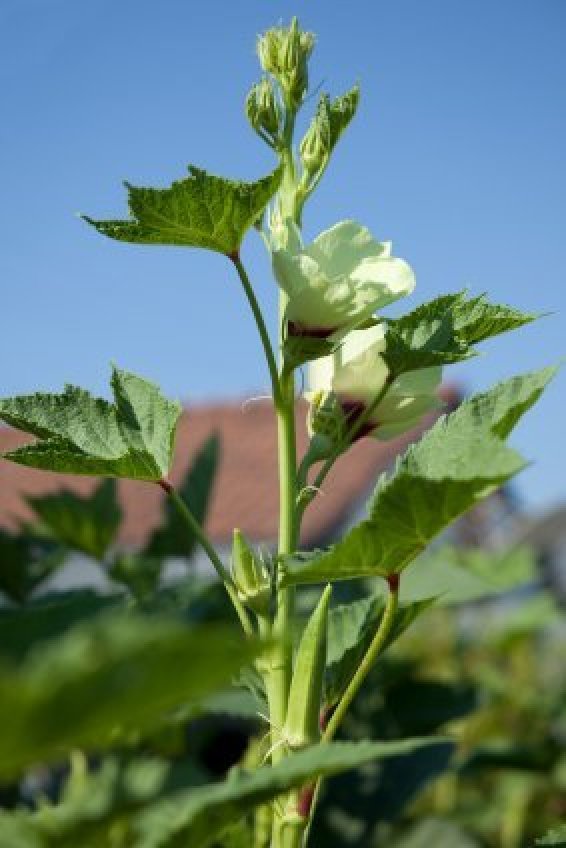

In the North, it’s wise to choose varieties that are intended for a short growing season.
OKRA FLOWER FULL
Okra requires full sun and will grow best in soil with a pH that is close to neutral.Īll varieties of okra - also known as okro, ochro and ladies’ fingers - are the same species, Abelmoschus esculentus. It also has the benefit of creating a barrier between the plant foliage and pathogens in the soil Mulch will retain moisture between waterings and will keep the soil warm on cool nights. Water immediately upon planting and cover the ground with a layer of two to three inches of organic mulch. If a cool night is coming, cover the crop with floating row cover during the day to retain heat.īe extra careful while placing seedlings in the ground. Once planted, okra prefers the temperature to be over 60º consistently. Northern growers can raise the soil temperature by laying black plastic over the planting location a month before planting out the seedlings. Okra seedlings enjoy a soil temperature that is at least 70º. The test results will give you an idea of what soil amendments to add, if any. To check the soil’s pH and fertility, get an inexpensive soil test. Okra also has moderate nutrient needs, so don’t go overboard on fertilizer.
/okra--hibiscus-esculentus--star-of-david---in-fruit-135608015-5b378dd0c9e77c0037736662.jpg)
Okra requires full sun and will grow best in soil with a pH that is close to neutral, which is 7.0, so anything from 6.0 to 8.0 will work. Whether planting seeds, store-bought seedlings or home-grown seedlings, space them 12 inches apart in soil that is well-draining and amended with lots of compost or organic matter. In southern climates, okra may be direct sown after the last possible frost date. By the end of this period the plants will be ready to receive a full day of direct sun. ” Put seedlings out for a short time on the first day - a half hour - and increase the time spent outdoors each day for a week to 10 days. Also, keep the seedlings under a grow light for eight hours a day so the plants don’t stretch out as they reach for light.īefore okra seedlings are planted outdoors, they should be gradually introduced to the sun in a process known as “ hardening off. Ensure the seed starting mix is warm enough by using a seedling heat mat with a thermostat. In soil that is between 70º and 95º Fahrenheit, the seeds should germinate in 5 to 14 days. Soak the seeds overnight in warm water to hasten germination then plant the seeds three-quarters of an inch deep in sterile seed starting mix.

Okra can be started from seed indoors four to six weeks between the last possible frost date. Although it grows over a wide range - from zone 4 to 11 - don’t sow seeds outdoors or plant out seedlings until all risk of spring frost has passed. The hairs on the seed pods can be an irritant to some people and gloves should be worn when harvesting.Okra is related to hibiscus but produces large edible pods as well as flowers.Keep an eye out for aphids, slugs, and white flies.long (7 cm), about 4 months after sowing, though some early maturing varieties can produce a crop in 50 days in the tropics. Harvest the pods when they reach 3 in.It should not be planted outside until soil temperatures have risen to 60✯ (15✬) and it dislikes low night temperatures below 55✯ (12✬). This plant requires a warm sunny position sheltered from winds. Thrives in full sun, moist, moderately fertile, well-drained soils.Widely cultivated or naturalized in the tropics and subtropics of the Western Hemisphere. The leaves, flower buds, flowers and calyces can be eaten cooked as greens. Blooming freely throughout the growing season, the blossoms give way to fruit capsules that can be used fresh or dried, and can also be cooked on their own or added to soups or stews. across (5-7 cm), in shades of yellow, pink, orange and red with contrasting centers. Grown for its edible fruit, Abelmoschus esculentus (Okra) is an annual boasting hibiscus-like flowers, 2-3 in.


 0 kommentar(er)
0 kommentar(er)
